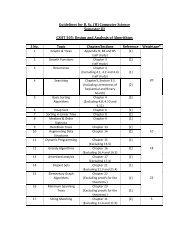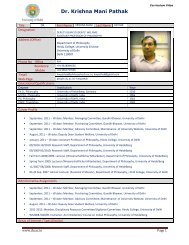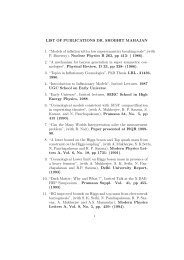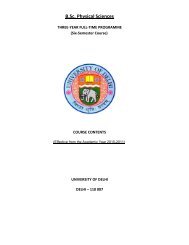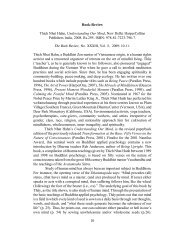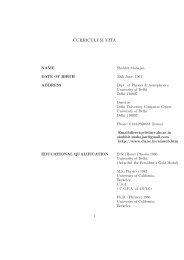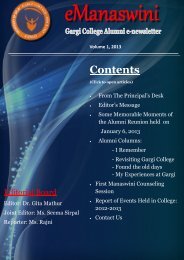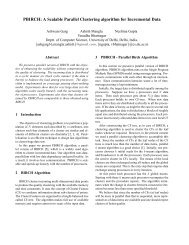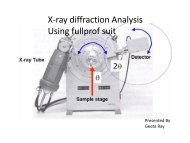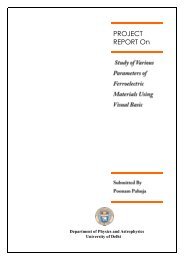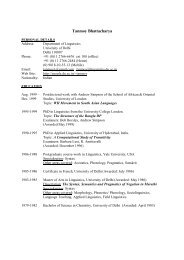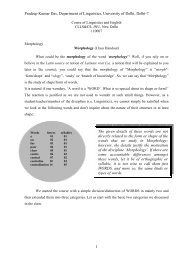Clay illuviation in calcareous soils of the semiarid - Home Pages of ...
Clay illuviation in calcareous soils of the semiarid - Home Pages of ...
Clay illuviation in calcareous soils of the semiarid - Home Pages of ...
You also want an ePaper? Increase the reach of your titles
YUMPU automatically turns print PDFs into web optimized ePapers that Google loves.
<strong>Clay</strong> <strong>illuviation</strong> <strong>in</strong> <strong>calcareous</strong> <strong>soils</strong> <strong>of</strong> <strong>the</strong> <strong>semiarid</strong><br />
part <strong>of</strong> <strong>the</strong> Indo-Gangetic Pla<strong>in</strong>s, India<br />
Abstract<br />
D.K. Pal*, P. Srivastava, T. Bhattacharyya<br />
Division <strong>of</strong> Soil Resource Studies, National Bureau <strong>of</strong> Soil Survey and Land Use Plann<strong>in</strong>g,<br />
Amravati Road, Nagpur 440 010, India<br />
Received 28 May 2002; received <strong>in</strong> revised form 12 November 2002; accepted 9 December 2002<br />
In view <strong>of</strong> diverse understand<strong>in</strong>g on <strong>the</strong> movement and accumulation <strong>of</strong> clay particles <strong>in</strong><br />
<strong>calcareous</strong> parent material, a micromorphological study on 28 Alfisols <strong>of</strong> <strong>the</strong> <strong>semiarid</strong> part <strong>of</strong> <strong>the</strong><br />
Indo-Gangetic Pla<strong>in</strong>s (IGP) was undertaken. The study <strong>in</strong>dicates that <strong>the</strong> identified clay ped<strong>of</strong>eatures<br />
are typically <strong>of</strong> <strong>the</strong> type ‘‘impure clay ped<strong>of</strong>eatures’’ which have resulted from <strong>the</strong> impairment <strong>of</strong> <strong>the</strong><br />
parallel orientation <strong>of</strong> <strong>the</strong> clay platelets <strong>in</strong>duced by dispersion <strong>of</strong> both clay and silt size layer silicates<br />
<strong>in</strong> slightly to highly sodic environment. The study also <strong>in</strong>dicates that <strong>the</strong> <strong>illuviation</strong> <strong>of</strong> clay particles<br />
and <strong>the</strong>ir subsequent accumulation <strong>in</strong> <strong>the</strong> Bt horizons have occurred <strong>in</strong> sodic environment caused by<br />
<strong>the</strong> precipitation <strong>of</strong> soluble Ca 2+ ions as calcium carbonate (CaCO3), thus discount<strong>in</strong>g any role <strong>of</strong><br />
soluble Ca 2+ ions and <strong>the</strong> presence <strong>of</strong> CaCO 3 <strong>in</strong> prevent<strong>in</strong>g <strong>the</strong> movement and accumulation <strong>of</strong> clay<br />
particles. The study thus suggests that <strong>the</strong> formation <strong>of</strong> impure clay ped<strong>of</strong>eatures and pedogenic<br />
CaCO3 are two pedogenic processes occurr<strong>in</strong>g simultaneously <strong>in</strong> <strong>soils</strong> <strong>of</strong> <strong>the</strong> IGP as contemporary<br />
pedogenic events <strong>in</strong> <strong>the</strong> <strong>semiarid</strong> climate s<strong>in</strong>ce <strong>the</strong> last 4000 years B.P.<br />
D 2003 Elsevier Science B.V. All rights reserved.<br />
Keywords: CaCO 3; Sodic environment; <strong>Clay</strong> <strong>illuviation</strong>; Pedogenesis; Pedogenic threshold<br />
1. Introduction<br />
Geoderma 115 (2003) 177–192<br />
The clay particles move <strong>in</strong> a suspended state. When <strong>the</strong> water is absorbed by <strong>the</strong> dry<br />
peds, <strong>the</strong> ped faces or void walls act as a filter reta<strong>in</strong><strong>in</strong>g <strong>the</strong> clay platelets that are deposited<br />
<strong>in</strong> <strong>the</strong> subsurface horizons. These platelets are oriented parallel to <strong>the</strong> surface <strong>of</strong> deposition<br />
* Correspond<strong>in</strong>g author.<br />
E-mail address: dkpal@nbsslup.mah.nic.<strong>in</strong> (D.K. Pal).<br />
0016-7061/03/$ - see front matter D 2003 Elsevier Science B.V. All rights reserved.<br />
doi:10.1016/S0016-7061(02)00377-4<br />
www.elsevier.com/locate/geoderma
178<br />
D.K. Pal et al. / Geoderma 115 (2003) 177–192<br />
giv<strong>in</strong>g rise to optically oriented argillans through <strong>the</strong> process <strong>of</strong> clay <strong>illuviation</strong> (Soil<br />
Survey Staff, 1975). Illuviation <strong>of</strong> clay is considered to be an important pedogenetic<br />
process <strong>in</strong> soil formation. <strong>Clay</strong> accumulation through <strong>illuviation</strong> <strong>in</strong> <strong>soils</strong> is an established<br />
fact s<strong>in</strong>ce <strong>the</strong> presence <strong>of</strong> illuvial clay horizon known as argillic horizon has been<br />
recognized as a subsurface diagnostic criterion to group <strong>soils</strong> at order level <strong>in</strong> Soil<br />
Taxonomy (Soil Survey Staff, 1975, 1999) which f<strong>in</strong>ds application <strong>in</strong> <strong>the</strong> preparation <strong>of</strong> <strong>the</strong><br />
legend <strong>of</strong> Soil Map <strong>of</strong> <strong>the</strong> World (FAO/UNESCO, 1974).<br />
The argillic (textural B) horizons <strong>of</strong> large number <strong>of</strong> <strong>calcareous</strong> non-sodic and sodic<br />
<strong>soils</strong> developed <strong>in</strong> loamy-textured parent material and <strong>in</strong> <strong>the</strong> <strong>semiarid</strong> part <strong>of</strong> Indo-<br />
Gangetic Pla<strong>in</strong>s <strong>of</strong> India (IGP) are developed due to <strong>illuviation</strong> <strong>of</strong> <strong>the</strong> f<strong>in</strong>e clay under ustic<br />
soil moisture regime (Karale et al., 1974; Sehgal et al., 1975; Bhargava et al., 1981;<br />
Manchanda et al., 1983; Pal and Bhargava, 1985; Tomar, 1987; Pal et al., 1994; Srivastava<br />
et al., 1994; Kumar et al., 1996; Srivastava, 2001; Srivastava and Parkash, 2002).<br />
However, <strong>the</strong> <strong>illuviation</strong> <strong>of</strong> clay has not always resulted <strong>in</strong> <strong>the</strong> presence <strong>of</strong> dist<strong>in</strong>ct void<br />
argillans. Instead, <strong>the</strong> ped<strong>of</strong>eatures without dist<strong>in</strong>ct lam<strong>in</strong>ation, poorly oriented and with<br />
low birefr<strong>in</strong>gence (Karale et al., 1974; Kooistra, 1982; Pal et al., 1994) appear to be<br />
common <strong>in</strong> <strong>soils</strong> <strong>of</strong> <strong>the</strong> IGP and thus qualify to be impure clay ped<strong>of</strong>eatures (Pal et al.,<br />
1994) accord<strong>in</strong>g to Bullock et al. (1985).<br />
Presence <strong>of</strong> clay ped<strong>of</strong>eatures and calcium carbonate (CaCO3) is common <strong>in</strong> <strong>soils</strong> <strong>of</strong><br />
arid and <strong>semiarid</strong> climates not only <strong>in</strong> <strong>the</strong> IGP but also elsewhere (Gile, 1970, 1975;<br />
Reynders, 1972; Allen and Goss, 1974; Eswaran and Sys, 1979; El-Tezhani et al., 1984;<br />
Reheis, 1987). A calcic horizon conta<strong>in</strong><strong>in</strong>g translocated clay is commonly <strong>in</strong>terpreted to<br />
represent a climate change (Reheis, 1987). Gile et al. (1966) and Reynders (1972)<br />
<strong>in</strong>dicated that clay was translocated <strong>in</strong> a moister climate but was later engulfed by<br />
carbonate when climate became drier, and <strong>the</strong> clay orientation was also disturbed by<br />
accumulation <strong>of</strong> carbonate (Reynders, 1972). The opposite relation, argillans coat<strong>in</strong>g<br />
carbonate masses or nodules represent<strong>in</strong>g a climatic change from dry to wet, has been<br />
reported only rarely (Yarilova, 1964). Allan and Hole (1968) and Arnold (1965), however,<br />
implied that for <strong>soils</strong> develop<strong>in</strong>g <strong>in</strong> <strong>calcareous</strong> materials, <strong>the</strong> carbonate must be removed<br />
before <strong>the</strong> clay is mobilized. Like <strong>the</strong>m, many researchers (Jenny, 1941; Smith et al., 1950;<br />
Culver and Gray, 1968; Dankert and Drew, 1970; Schaetzl, 1996; Timpson et al., 1996)<br />
have postulated carbonate removal as a criterion for <strong>illuviation</strong> <strong>of</strong> clay. Bartelli and Odell<br />
(1960) op<strong>in</strong>ed that <strong>the</strong> calcium ion enhances flocculation and immobilization <strong>of</strong> colloidal<br />
material. However, Brewer and Haldane (1957) <strong>in</strong>dicated that calcium had no <strong>in</strong>fluence on<br />
<strong>the</strong> development <strong>of</strong> clay sk<strong>in</strong>s when produced artificially. Gile and Hawley (1972)<br />
concluded that abundant carbonate <strong>in</strong> alluvial parent materials can prevent <strong>the</strong> develop-<br />
Fig. 1. Locations <strong>of</strong> Haplustalfs and Natrustalfs <strong>in</strong> <strong>the</strong> Gangetic Pla<strong>in</strong>s <strong>in</strong> <strong>the</strong> states <strong>of</strong> Haryana and Uttar Pradesh<br />
(UP): 1–28 Pedon numbers: 1—Zarifa Viran, Haryana; 2—Sakit, UP; 3—Bareilly, UP; 4—Kant, Shahajahanpur,<br />
UP; 5—Jalalpur, Shahajahanpur, UP; 6—Barwar, Sitapur, UP; 7—Nab<strong>in</strong>agar, Bahraich, UP; 8—Nanpara,<br />
Bahraich, UP; 9—Nawabganj, Bahraich, UP; 10—Azamgarh, UP; 11—Azamgarh 2, UP; 12—Hargaon, Sitapur,<br />
UP; 13—Khairabad, Sitapur, UP; 14—Bikapur, Sultanpur, UP; 15—Amethi, Sultanpur, UP; 16—Sheogarh,<br />
Allahabad, UP; 17—Jankipur, Gonda, UP; 18—Ranipur, Uturolla, UP; 19—Dudhara, Basti, UP; 20—Misa, Etah,<br />
UP; 21—Mihole, Etah, UP; 22—Nagla Bitch, Etah, UP; 23—Hasangarh, 1, Etah, UP; 24—Rajarampur, Etah,<br />
UP; 25—Hasangarh 2, Etah, UP; 26—Hasangarh 3, Etah, UP; 27—Daulatpur 1, Etah, UP; 28—Daulatpur 2,<br />
Etah, UP.
D.K. Pal et al. / Geoderma 115 (2003) 177–192 179
180<br />
ment <strong>of</strong> argillic horizons. Experimental studies by Goss et al. (1973) <strong>in</strong>dicated that clay<br />
particles can be translocated <strong>in</strong> a <strong>calcareous</strong> soil, despite <strong>the</strong> tendency <strong>of</strong> clay to flocculate<br />
<strong>in</strong> <strong>the</strong> presence <strong>of</strong> Ca 2+ ions, if channels or pores are available and if precipitation is<br />
adequate (Holliday, 1985).<br />
In view <strong>of</strong> <strong>the</strong> diversity <strong>in</strong> <strong>the</strong> understand<strong>in</strong>g <strong>of</strong> <strong>the</strong> genesis <strong>of</strong> clay ped<strong>of</strong>eatures <strong>in</strong><br />
<strong>calcareous</strong> <strong>soils</strong>, <strong>the</strong> present study was undertaken to exam<strong>in</strong>e factors <strong>in</strong>volved <strong>in</strong> and<br />
processes <strong>in</strong> <strong>the</strong>ir genesis <strong>in</strong> <strong>calcareous</strong> <strong>soils</strong> <strong>in</strong> general, and <strong>in</strong> <strong>calcareous</strong> non-sodic and<br />
sodic <strong>soils</strong> <strong>of</strong> <strong>the</strong> IGP <strong>in</strong> particular <strong>in</strong> <strong>the</strong> light <strong>of</strong> available data on micromorphological,<br />
m<strong>in</strong>eralogical, physical and chemical properties <strong>of</strong> <strong>the</strong>se <strong>soils</strong> (Murthy et al., 1982;<br />
Kooistra, 1982; Pal et al., 1994; Srivastava et al., 1994; Srivastava, 2001; Srivastava and<br />
Parkash, 2002), supplemented by newly acquired data <strong>in</strong> <strong>the</strong> Soil Resource Studies<br />
Division. It is hoped that despite <strong>the</strong> major gaps <strong>in</strong> understand<strong>in</strong>g clay <strong>illuviation</strong> and <strong>the</strong><br />
formation <strong>of</strong> argillic horizons (Eswaran and Sys, 1979; Bullock and Thompson, 1985), <strong>the</strong><br />
present work will be <strong>of</strong> value not only for <strong>calcareous</strong> <strong>soils</strong> <strong>of</strong> <strong>the</strong> IGP but also for similar<br />
<strong>soils</strong> occurr<strong>in</strong>g elsewhere.<br />
2. Materials and methods<br />
The study area covers <strong>the</strong> <strong>semiarid</strong> parts <strong>of</strong> <strong>the</strong> northwestern and north–central IGP <strong>in</strong><br />
<strong>the</strong> states <strong>of</strong> Haryana and Uttar Pradesh (Fig. 1). Twenty-eight Alfisols were selected for<br />
detailed micromorphological study <strong>of</strong> <strong>the</strong> clay ped<strong>of</strong>eatures. Details <strong>of</strong> <strong>the</strong>ir location,<br />
climate, parent material and classification are given <strong>in</strong> Table 1.<br />
The characteristics <strong>of</strong> each pedon and its <strong>in</strong>dividual horizons were described follow<strong>in</strong>g<br />
<strong>the</strong> procedure <strong>of</strong> <strong>the</strong> Soil Survey Manual (Soil Survey Staff, 1951). Most <strong>of</strong> <strong>the</strong> Natrustalfs<br />
Table 1<br />
Soil type, location, parent material, climate, classification and selected properties <strong>of</strong> <strong>soils</strong><br />
Pedon<br />
number<br />
Benchmark<br />
soil/soil<br />
series<br />
D.K. Pal et al. / Geoderma 115 (2003) 177–192<br />
State Parent<br />
material<br />
Bioclimatic<br />
zone<br />
Texture Soil<br />
reaction<br />
pH (1:2)<br />
Classification<br />
1 Zarifa<br />
Viran a<br />
Haryana Indo-Gangetic Semiarid F<strong>in</strong>e-loamy Alkal<strong>in</strong>e Typic<br />
alluvium<br />
Natrustalfs<br />
2 Sakit a,b<br />
Uttar Indo-Gangetic Semiarid F<strong>in</strong>e-loamy Alkal<strong>in</strong>e Typic<br />
Pradesh alluvium<br />
Natrustalfs<br />
3–20 17 identified<br />
<strong>soils</strong> <strong>of</strong> Lucknow,<br />
Sultanpur and<br />
Faizabad districts c<br />
Uttar Indo-Gangetic Semiarid Coarse-loamy to Neutral to Typic<br />
Pradesh alluvium<br />
f<strong>in</strong>e-loamy slightly Haplustalfs<br />
alkal<strong>in</strong>e<br />
21–28 9 identified<br />
<strong>soils</strong> <strong>of</strong> Etah<br />
district d,e<br />
Uttar Indo-Gangetic Semiarid Loamy Alkal<strong>in</strong>e Typic<br />
Pradesh alluvium<br />
Natrustalfs<br />
a<br />
Murthy et al. (1982).<br />
b<br />
Pal et al. (1994).<br />
c<br />
Srivastava et al. (1994).<br />
d<br />
Verma et al. (1995).<br />
e<br />
Sharma et al. (2000).
Table 2<br />
Physical and chemical properties <strong>of</strong> representative <strong>soils</strong><br />
Horizon Depth<br />
(cm)<br />
Particle size distribution <strong>of</strong> < 2 mm (g kg 1 ) pH 1:2 CaCO 3<br />
(g kg 1 )<br />
Exchangeable cations<br />
cmol (+) kg 1<br />
Sand (2000 –50 Am) Silt (50–2 Am) <strong>Clay</strong> (< 2 Am) Ca Mg Na K<br />
CEC<br />
cmol<br />
(+) kg 1<br />
ESP ECP ESP <strong>in</strong><br />
SCS<br />
Typic Haplustalf<br />
Ap 0 –11 444 383 173 8.3 10 6.0 4.0 0.2 0.3 10.0 2 60 4<br />
Bt1 11 – 41 392 392 216 8.2 15 6.4 3.0 0.3 0.3 10.3 3 62<br />
Bt2 41–71 360 412 228 8.5 20 5.5 2.3 0.4 0.3 11.0 4 50<br />
Btk 71–108 337 405 258 8.9 40 4.2 3.8 0.6 0.1 12.0 5 35<br />
Typic Natrustalf<br />
An1 0 –18 400 469 131 10.5 21 Nil Nil 5.9 0.4 6.0 98 Nil 93<br />
Btn1 18–40 260 470 270 10.4 25 0.1 0.1 16.0 0.4 16.4 97 0.6<br />
Btn2 40–70 220 480 300 10.5 25 0.1 0.1 20.0 0.6 20.6 97 Nil<br />
Btn3 70–102 222 450 328 10.3 32 0.5 0.5 17.5 0.5 20.1 87 2.5<br />
Btn4 102–150 199 500 301 10.3 121 0.8 0.7 12.5 0.5 15.2 82 5.2<br />
Btk 150–160 220 486 294 10.2 168 1.0 1.0 9.5 0.5 13.0 73 7.7<br />
D.K. Pal et al. / Geoderma 115 (2003) 177–192 181
182<br />
D.K. Pal et al. / Geoderma 115 (2003) 177–192<br />
are not cultivated because <strong>of</strong> <strong>the</strong>ir very high sodicity and <strong>the</strong>refore are barren at present.<br />
The <strong>soils</strong> belong to loamy-textural class, have strong structure and patchy clay sk<strong>in</strong>s. The<br />
<strong>soils</strong> are <strong>calcareous</strong> and have neutral to mildly alkal<strong>in</strong>e reaction <strong>in</strong> Haplustalfs but <strong>the</strong>y are<br />
highly alkal<strong>in</strong>e <strong>in</strong> Natrustalfs (Tables 1 and 2). The exchangeable sodium percentage<br />
(ESP) <strong>in</strong> soil control section (SCS) is very high <strong>in</strong> Natrustalfs (>25–100) and low <strong>in</strong><br />
Haplustalfs (< 15) (Murthy et al., 1982; Pal et al., 1994; Srivastava et al., 1994; Verma et<br />
Fig. 2. Representative photomicrographs <strong>of</strong> <strong>the</strong> important pedogenic features <strong>of</strong> <strong>the</strong> <strong>soils</strong> (a) strongly developed<br />
subangular blocky structure, Pedon 21, Etah, 75–90 cm, (b) moderately to strongly developed cross- and<br />
reticulate-striated b fabric, Pedon 28, Etah, 78–103 cm, (c) th<strong>in</strong> cont<strong>in</strong>uous clay coat<strong>in</strong>g along <strong>the</strong> m<strong>in</strong>eral gra<strong>in</strong>s,<br />
Pedon 16, 29–80 cm, (d) part <strong>of</strong> a large fragmented clay ped<strong>of</strong>eature, Pedon 20, Etah, 50–74 cm, (e) thick clay<br />
ped<strong>of</strong>eature along void, Pedon 13, Sitapur, 38–84 cm, (f) ferrug<strong>in</strong>ous clay ped<strong>of</strong>eature and diffused micritic<br />
nodule, Pedon 18, 50–66 cm. All photomicrographs between cross-polarized light. Black arrowhead <strong>in</strong>dicates<br />
clay ped<strong>of</strong>eatures and <strong>the</strong> white arrowhead <strong>in</strong>dicates CaCO3 features.
D.K. Pal et al. / Geoderma 115 (2003) 177–192 183<br />
al., 1995; Sharma et al., 2000). The soil temperature and moisture regimes are hyper<strong>the</strong>rmic<br />
and ustic, respectively (Soil Survey Staff, 1999).<br />
Undisturbed soil blocks 8 cm long, 6 cm wide and 5 cm thick were collected from soil<br />
horizons, and th<strong>in</strong> sections were prepared by <strong>the</strong> methods <strong>of</strong> Jongerius and He<strong>in</strong>tzberger<br />
(1975). They were described accord<strong>in</strong>g to <strong>the</strong> nomenclature <strong>of</strong> Bullock et al. (1985).<br />
Fig. 3. Representative photomicrographs <strong>of</strong> clay ped<strong>of</strong>eatures associated with carbonates. (a) Calcareous silty clay<br />
coat<strong>in</strong>g along a void, Pedon 20, Etah, 50–74 cm, (b) alternate lam<strong>in</strong>ation <strong>of</strong> clay and calcium carbonate <strong>in</strong> <strong>the</strong><br />
soil, Pedon 22, Etah, 51–77 cm, (c) th<strong>in</strong> clay coat<strong>in</strong>g over calcium carbonate coat<strong>in</strong>gs <strong>in</strong> voids, Pedon 13, Sitapur,<br />
38–84 cm, (d) th<strong>in</strong> clay coat<strong>in</strong>g <strong>in</strong> a void with<strong>in</strong> calcium carbonate nodule, Pedon 15, Sultanpur, 47–78 cm, (e)<br />
impure clay coat<strong>in</strong>g on a nodule <strong>of</strong> calcium carbonate, Pedon 18, Uturolla, 50–66 cm, (f) complex ped<strong>of</strong>eature<br />
with clay and calcium carbonate <strong>in</strong> a void, Pedon 26, Hasangarh 3, Etah, 50–68 cm. All photomicrographs<br />
between cross-polarized light. Black arrowhead <strong>in</strong>dicates clay ped<strong>of</strong>eatures and <strong>the</strong> white arrowhead <strong>in</strong>dicates<br />
CaCO3 features.
184<br />
Peds <strong>of</strong> <strong>the</strong> Bt horizons <strong>of</strong> representative Haplustalf and Natrustalf <strong>of</strong> <strong>the</strong> study area and<br />
benchmark acidic (pH f 5.6) ferrug<strong>in</strong>ous soil <strong>of</strong> sou<strong>the</strong>rn India (Vijayapura series, Oxic<br />
Haplustalf, Murthy et al., 1982) were broken to open <strong>the</strong> fresh surfaces and <strong>the</strong>n fixed on<br />
alum<strong>in</strong>ium stub with LEIT-C conductive cement. The samples were coated with gold, and<br />
exam<strong>in</strong>ed <strong>in</strong> a Philips Scann<strong>in</strong>g Electron Microscope (SEM) to study <strong>the</strong> orientation <strong>of</strong><br />
clay platelets <strong>in</strong> <strong>the</strong> voids.<br />
Particle size distribution was determ<strong>in</strong>ed by <strong>the</strong> <strong>in</strong>ternational pipette method after <strong>the</strong><br />
removal <strong>of</strong> organic matter, CaCO 3 and free iron, alum<strong>in</strong>ium oxides. Sand (2000–50 Am),<br />
silt (50–2 Am), total clay (< 2 Am) and f<strong>in</strong>e clay (< 0.2 Am) fractions were separated by <strong>the</strong><br />
procedure <strong>of</strong> Jackson (1979). Soil pH, electrical conductivity <strong>of</strong> <strong>the</strong> saturation extract<br />
(ECe) and soluble cations and anions <strong>in</strong> <strong>the</strong> saturation extracts were measured by standard<br />
methods (Richards, 1954). Cation exchange capacity (CEC) and exchangeable sodium and<br />
potassium were determ<strong>in</strong>ed follow<strong>in</strong>g <strong>the</strong> method <strong>of</strong> Richards (1954), substitut<strong>in</strong>g 1N<br />
Mg(NO3)2 <strong>of</strong> pH 8.6 for <strong>the</strong> NH4OAc to elim<strong>in</strong>ate <strong>the</strong> <strong>in</strong>fluence <strong>of</strong> zeolites and<br />
feldspathoid m<strong>in</strong>erals (Gupta et al., 1985). Exchangeable calcium and magnesium were<br />
determ<strong>in</strong>ed follow<strong>in</strong>g <strong>the</strong> 1N NaCl solution extraction method <strong>of</strong> Piper (1966).<br />
The silt and clay fractions were subjected to X-ray diffraction (XRD) analyses <strong>of</strong><br />
parallel-oriented slide mounts after Ca- and K-saturation, Ca-glycolation us<strong>in</strong>g ethylene<br />
glycol and heat treatment <strong>of</strong> K-saturated samples at 25, 100, 300 and 550 jC, and also HCl<br />
treatment us<strong>in</strong>g a Philips diffractometer with Ni-filtered CuKa radiation and a scann<strong>in</strong>g<br />
speed <strong>of</strong> 2j 2h per m<strong>in</strong>ute. Semi-quantitative estimates <strong>of</strong> <strong>the</strong> clay m<strong>in</strong>erals were made<br />
follow<strong>in</strong>g <strong>the</strong> pr<strong>in</strong>ciples outl<strong>in</strong>ed by Gjems (1967) and Kapoor (1972).<br />
3. Results<br />
3.1. Micromorphological characteristics<br />
D.K. Pal et al. / Geoderma 115 (2003) 177–192<br />
The detailed micromorphology <strong>of</strong> <strong>soils</strong> with regard to clay ped<strong>of</strong>eatures were recorded,<br />
as this method is <strong>the</strong> best for identify<strong>in</strong>g illuvial clay (Bullock and Thompson, 1985). Soils<br />
<strong>of</strong> <strong>the</strong> present study have developed subangular blocky microstructure with channel and<br />
vughs (Fig. 2a). In <strong>the</strong> B horizons, <strong>the</strong> percentage <strong>of</strong> coarse m<strong>in</strong>eral gra<strong>in</strong>s decreases and<br />
that <strong>of</strong> f<strong>in</strong>e fraction <strong>in</strong>creases. The relative distribution pattern is open porphyric. The<br />
coarse fraction consists <strong>of</strong> quartz, biotite, muscovite, feldspars and heavy m<strong>in</strong>erals. The<br />
f<strong>in</strong>e fraction (< 20 Am) is micaceous with micrite crystals at places. The pores are<br />
Fig. 4. Representative scann<strong>in</strong>g electron microscopic features <strong>of</strong> illuvial clay <strong>in</strong> <strong>soils</strong> <strong>of</strong> <strong>the</strong> Gangetic Pla<strong>in</strong>s along<br />
with petrographic and SEM features <strong>of</strong> ferrug<strong>in</strong>ous <strong>soils</strong> <strong>of</strong> sou<strong>the</strong>rn India. (a) Full view <strong>of</strong> illuvial clay<br />
ped<strong>of</strong>eature along a void, Pedon 13, Sitapur, 38–84 cm, (b) expanded part <strong>of</strong> <strong>the</strong> same show<strong>in</strong>g poorly oriented<br />
clay platelets, (c) optical photomicrograph <strong>in</strong> cross-polarized light <strong>of</strong> strongly oriented void argillan from<br />
ferrug<strong>in</strong>ous <strong>soils</strong> show<strong>in</strong>g microlam<strong>in</strong>ations, Vijayapura, 21–46 cm, (d) <strong>the</strong> same under SEM show<strong>in</strong>g strong<br />
orientation <strong>of</strong> f<strong>in</strong>e clay coat<strong>in</strong>g <strong>in</strong> <strong>the</strong> void, (e) expanded part <strong>of</strong> <strong>the</strong> same show<strong>in</strong>g strong parallel lam<strong>in</strong>ation <strong>of</strong><br />
f<strong>in</strong>e clay particles, (f) micritic to sparitic gra<strong>in</strong>s along with alluvial clay ped<strong>of</strong>eature, Pedon 13, Sitapur, 38–84<br />
cm, (g) expanded view <strong>of</strong> (f) show<strong>in</strong>g precipitation <strong>of</strong> CaCO3 between <strong>the</strong> poorly oriented clay platelets. Black<br />
arrowhead <strong>in</strong>dicates clay ped<strong>of</strong>eatures and <strong>the</strong> white arrowhead <strong>in</strong>dicates CaCO 3 features.
D.K. Pal et al. / Geoderma 115 (2003) 177–192 185
186<br />
D.K. Pal et al. / Geoderma 115 (2003) 177–192<br />
comprised <strong>of</strong> randomly distributed, elongated and equant voids, vughs and channels.<br />
Carbonate and sesquioxide accumulations are observed throughout <strong>the</strong> soil depth. Plasma<br />
separation is moderate to strong. Cross- and reticulate-striated fabrics were observed <strong>in</strong><br />
lower parts <strong>of</strong> <strong>the</strong> pedons (Fig. 2b).<br />
There are four types <strong>of</strong> illuvial clay ped<strong>of</strong>eatures: (i) clay <strong>in</strong>tercalations and th<strong>in</strong> clay<br />
coat<strong>in</strong>gs around m<strong>in</strong>eral gra<strong>in</strong>s (Fig. 2c), (ii) disrupted clay ped<strong>of</strong>eatures occurr<strong>in</strong>g as<br />
remnant <strong>of</strong> earlier clay ped<strong>of</strong>eatures (Fig. 2d), (iii) clay ped<strong>of</strong>eatures occurr<strong>in</strong>g <strong>in</strong> voids<br />
(Fig. 2e) and (iv) clay coat<strong>in</strong>gs that are <strong>in</strong>timately associated with CaCO 3 coat<strong>in</strong>gs and<br />
nodules (Figs. 2f and 3a–f). The <strong>in</strong>ternal boundaries <strong>of</strong> <strong>the</strong>se features are generally<br />
dist<strong>in</strong>ct. These ped<strong>of</strong>eatures under cross-polarized light are yellowish brown to dark<br />
yellowish red, mostly without dist<strong>in</strong>ct lam<strong>in</strong>ation, are poorly oriented and have low<br />
birefr<strong>in</strong>gence. Thus, <strong>the</strong>y qualify as impure clay ped<strong>of</strong>eatures (Bullock et al., 1985). They<br />
occupy more than 1% area <strong>of</strong> <strong>the</strong> th<strong>in</strong> section. Impure clay ped<strong>of</strong>eatures are common <strong>in</strong><br />
<strong>soils</strong> <strong>of</strong> <strong>the</strong> <strong>semiarid</strong> part <strong>of</strong> <strong>the</strong> IGP (Fedor<strong>of</strong>f and Courty, 1986; Pal et al., 1994).<br />
Disrupted clay ped<strong>of</strong>eatures were hi<strong>the</strong>rto <strong>in</strong>terpreted as features <strong>of</strong> paleoclimatic<br />
significance (Brewer, 1964; Bullock et al., 1985; Kemp, 1999). The presence <strong>of</strong> typical<br />
impure clay ped<strong>of</strong>eatures has so far been expla<strong>in</strong>ed <strong>in</strong> terms <strong>of</strong> impairment <strong>of</strong> <strong>the</strong> parallel<br />
orientation <strong>of</strong> <strong>the</strong> clay platelets <strong>in</strong>duced by <strong>the</strong> disruption <strong>of</strong> both clay and silt size layer<br />
silicates <strong>in</strong> sodic environment (Pal et al., 1994). Explanations so far proposed, however, do<br />
not resolve <strong>the</strong> prevail<strong>in</strong>g diverse understand<strong>in</strong>g <strong>in</strong> <strong>the</strong> genesis <strong>of</strong> void argillans <strong>in</strong><br />
<strong>calcareous</strong> parent material (Jenny, 1941; Smith et al., 1950; Bartelli and Odell, 1960;<br />
Allan and Hole, 1968; Arnold, 1965; Culver and Gray, 1968; Dankert and Drew, 1970;<br />
Gile and Hawley, 1972; Goss et al., 1973), especially for clay ped<strong>of</strong>eatures alternat<strong>in</strong>g<br />
with CaCO 3 coat<strong>in</strong>gs (Fig. 3f) that have been understood to be an effect <strong>of</strong> climate change<br />
(Yarilova, 1964; Gile et al., 1966; Reynders, 1972; Reheis, 1987). This could be <strong>the</strong> reason<br />
why <strong>the</strong> development <strong>of</strong> void argillans and CaCO3 formation are hi<strong>the</strong>rto considered to be<br />
two <strong>in</strong>dependent pedogenic processes depict<strong>in</strong>g two dist<strong>in</strong>ctly different set <strong>of</strong> climate<br />
(Eswaran and Sys, 1979).<br />
Table 3<br />
Chemical composition <strong>of</strong> <strong>the</strong> saturation <strong>of</strong> representative <strong>soils</strong><br />
Horizon Depth ECe pH Soluble cations Soluble anions<br />
(cm) dS m 1<br />
Ca 2+ Mg 2+ Na +<br />
K +<br />
Cl SO4 2<br />
HCO3 CO3 2<br />
Typic Haplustalf<br />
Ap 0 – 11 0.9 8.3 3.2 1.9 10.7 0.4 12.5 1.7 2.0 Nil<br />
Bt1 11–41 0.9 8.2 2.6 8.2 8.2 0.2 12.0 2.2 5.0 Nil<br />
Bt2 41–71 1.3 8.5 4.4 8.1 10.0 0.2 11.9 4.3 6.5 Nil<br />
Btk 71–108 0.1 8.9 4.5 4.2 13.5 0.2 11.5 1.1 9.8 Nil<br />
Typic Natrustalf<br />
An1 0 – 18 2.9 10.5 2.6 0.7 1213.7 0.6 167.5 871.4 13.7 164.0<br />
Btn1 18–40 9.0 10.4 2.0 0.6 696.3 0.3 137.9 471.7 25.6 64.0<br />
Btn2 40–70 5.8 10.5 2.4 0.5 452.1 0.2 144.4 232.0 18.2 60.1<br />
Btn3 70–102 4.9 10.3 2.0 0.3 195.6 0.4 80.0 84.2 6.8 27.3<br />
Btn4 102–150 2.7 10.3 1.4 3.2 218.1 0.3 82.4 96.3 44.3 Nil<br />
BtK 150–160 2.5 10.2 2.7 2.2 202.4 0.3 17.2 162.1 28.3 Nil
3.2. Exam<strong>in</strong>ation <strong>of</strong> clay platelets under SEM<br />
D.K. Pal et al. / Geoderma 115 (2003) 177–192 187<br />
In order to confirm <strong>the</strong> impairment <strong>of</strong> <strong>the</strong> parallel orientation <strong>of</strong> <strong>the</strong> clay platelets as<br />
observed under petrographic microscope, voids <strong>of</strong> Haplustalf and Natrustalf under SEM<br />
<strong>in</strong>dicated that both silt and clay size platelets are not oriented parallel to <strong>the</strong> surface <strong>of</strong><br />
deposition (Fig. 4a and b). Due to lack <strong>of</strong> such orientation, <strong>the</strong>y are not optically oriented<br />
argillans (Soil Survey Staff, 1975). To prove this po<strong>in</strong>t fur<strong>the</strong>r, voids <strong>of</strong> a representative<br />
acid ferrug<strong>in</strong>ous soil (Oxic Haplustalf) <strong>in</strong>dicated <strong>the</strong> presence <strong>of</strong> pure void argillans (Fig.<br />
4c) and also strongly oriented clay platelets (Fig. 4d and e). The clay platelets rema<strong>in</strong> <strong>in</strong><br />
face-to-face or parallel, or oriented aggregation when <strong>the</strong> flocculation <strong>of</strong> <strong>the</strong> clay<br />
suspension is not <strong>in</strong>duced by <strong>the</strong> presence <strong>of</strong> salts (van Olphen, 1966). The poor<br />
orientation <strong>of</strong> clay platelets suggests that even a mild environment <strong>of</strong> carbonate and<br />
bicarbonate <strong>of</strong> sodium (Table 3) would result <strong>in</strong> deflocculation, disengag<strong>in</strong>g face-to-face<br />
association <strong>of</strong> clay platelets (van Olphen, 1966) which would impair <strong>the</strong> parallel<br />
orientation <strong>of</strong> clay platelets. Poorly oriented clay platelets are <strong>of</strong>ten found associated with<br />
CaCO3 gra<strong>in</strong>s (Fig. 4f and g).<br />
Fig. 5. Changes <strong>in</strong> clay size mica and vermiculite plus smectite with pedon depth <strong>in</strong> representative Haplustalf (a)<br />
and Natrustalf (b).
188<br />
3.3. Depth distribution <strong>of</strong> clay m<strong>in</strong>erals, CEC, exchangeable sodium and ESP<br />
The presence <strong>of</strong> field-identifiable clay sk<strong>in</strong>s and impure clay ped<strong>of</strong>eatures confirm <strong>the</strong><br />
<strong>illuviation</strong> <strong>of</strong> clay. As a result, clay <strong>in</strong>creases considerably with depth. The ratio <strong>of</strong> clay<br />
content <strong>of</strong> <strong>the</strong> Bt horizon to that <strong>of</strong> <strong>the</strong> A horizon is >1.2. Like clay, <strong>the</strong> CEC and ES<br />
values <strong>in</strong>crease with depth down to <strong>the</strong> Bt horizons and <strong>the</strong>n decrease <strong>in</strong> both Haplustalf<br />
and Natrustalf (Table 2).<br />
The <strong>illuviation</strong> <strong>of</strong> clay has also resulted <strong>in</strong> a typical depth distribution <strong>of</strong> mica and<br />
vermiculite plus smectite <strong>in</strong> <strong>the</strong> whole clay fraction <strong>of</strong> <strong>the</strong> <strong>soils</strong> (Fig. 5). This has been<br />
expla<strong>in</strong>ed by preferential movement <strong>of</strong> vermiculite and smectite along with f<strong>in</strong>e clay<br />
fractions <strong>in</strong>to <strong>the</strong> B horizons result<strong>in</strong>g <strong>in</strong> an <strong>in</strong>crease <strong>in</strong> <strong>the</strong> proportion <strong>of</strong> mica <strong>in</strong> <strong>the</strong> A<br />
horizon, and that <strong>of</strong> vermiculite and smectite <strong>in</strong> <strong>the</strong> B horizons (Pal and Bhargava, 1985;<br />
Pal et al., 1994). This suggests that movement <strong>of</strong> <strong>the</strong> f<strong>in</strong>er clay particles <strong>in</strong> a deflocculated<br />
form can enrich B horizons with clay. Due to loss <strong>of</strong> clay <strong>in</strong> <strong>the</strong> A horizons and ga<strong>in</strong> <strong>the</strong><br />
Na-clay <strong>in</strong> <strong>the</strong> B horizons, both ES and CEC show an <strong>in</strong>crease with depth <strong>in</strong> both<br />
Haplustalfs and Naturstalfs. However, due to low amount <strong>of</strong> soluble bicarbonate and<br />
carbonate <strong>of</strong> sodium (Table 3), Haplustalfs show an <strong>in</strong>crease <strong>in</strong> ESP with depth. By<br />
contrast, Natrustalfs show decreas<strong>in</strong>g trend <strong>in</strong> ESP with depth amidst very high amount <strong>of</strong><br />
soluble sodium bicarbonate and carbonate (Table 3) and low amount <strong>of</strong> clay and CEC <strong>in</strong><br />
<strong>the</strong> upper horizons (Table 2).<br />
4. Discussion<br />
D.K. Pal et al. / Geoderma 115 (2003) 177–192<br />
The results <strong>of</strong> <strong>the</strong> study clearly <strong>in</strong>dicate <strong>the</strong> <strong>illuviation</strong> <strong>of</strong> clay particles <strong>in</strong> <strong>calcareous</strong><br />
<strong>soils</strong> with loamy-textured parent material under <strong>the</strong> ustic soil moisture regime. However,<br />
<strong>illuviation</strong> <strong>of</strong> clay has resulted only <strong>in</strong> ‘‘impure clay ped<strong>of</strong>eatures’’ because <strong>the</strong> parallel<br />
orientation <strong>of</strong> <strong>the</strong> clay platelets has been impaired by deflocculation <strong>of</strong> <strong>the</strong> clay colloids<br />
(Pal et al., 1994). This suggests that <strong>the</strong> removal <strong>of</strong> CaCO3 is less important for <strong>the</strong><br />
movement <strong>of</strong> clay as suggested earlier (Jenny, 1941; Smith et al., 1950; Bartelli and Odell,<br />
1960; Culver and Gray, 1968; Dankert and Drew, 1970; Gile and Hawley, 1972). It was<br />
thought earlier that calcium ion enhances flocculation and immobilization <strong>of</strong> colloidal<br />
material (Bartelli and Odell, 1960). However, <strong>the</strong> pH <strong>of</strong> a system conta<strong>in</strong><strong>in</strong>g CaCO 3 <strong>in</strong><br />
water <strong>in</strong> equilibrium with <strong>the</strong> atmosphere is 8.4 and <strong>the</strong> ionic strength is so low that<br />
correction for <strong>the</strong> difference <strong>of</strong> molality and activity is hardly worthwhile (Garrels and<br />
Christ, 1965). Marshall (1964) <strong>in</strong>dicates that CaCO3 ma<strong>in</strong>ta<strong>in</strong>s a concentration <strong>of</strong> Ca 2+<br />
ions <strong>in</strong> a solution <strong>of</strong> 0.25–5.00 meq/l, depend<strong>in</strong>g on <strong>the</strong> partial pressure <strong>of</strong> CO2 <strong>in</strong> contact<br />
with it. Rimmer and Greenland (1976) also po<strong>in</strong>ted out that at a calcium concentration <strong>of</strong> 5<br />
meq/l, <strong>the</strong> swell<strong>in</strong>g <strong>of</strong> Ca-montmorillonite is only 15% less than that <strong>in</strong> distilled water. The<br />
saturation extract <strong>of</strong> Haplustalfs and Natrustalfs under study <strong>in</strong>dicates a very low amount<br />
<strong>of</strong> Ca 2+ ions (b5 meq/l) as compared to Na + ions (H10 meq/l) (Table 3). It thus suggests<br />
that <strong>the</strong> presence <strong>of</strong> CaCO3 has m<strong>in</strong>imal role to cause flocculation <strong>of</strong> clay particles or<br />
<strong>in</strong>hibition <strong>of</strong> swell<strong>in</strong>g <strong>of</strong> expand<strong>in</strong>g m<strong>in</strong>erals <strong>in</strong> <strong>the</strong> clay fractions (Fig. 5) by contract<strong>in</strong>g<br />
<strong>the</strong>ir diffuse double layers (Pal et al., 2000). This suggests that movement <strong>of</strong> deflocculated<br />
clay and its subsequent deposition on <strong>the</strong> void walls or ped faces is possible <strong>in</strong> <strong>calcareous</strong>
D.K. Pal et al. / Geoderma 115 (2003) 177–192 189<br />
<strong>soils</strong>. This fact has already been demonstrated experimentally by Goss et al. (1973). The<br />
CaCO3 <strong>of</strong> <strong>the</strong> <strong>soils</strong> occur as irregular-shaped nodules as <strong>in</strong>fill<strong>in</strong>gs, and coat<strong>in</strong>gs <strong>of</strong> micrite<br />
<strong>in</strong> voids and gra<strong>in</strong>s, and <strong>of</strong>ten occurs toge<strong>the</strong>r with illuvial clay ped<strong>of</strong>eatures (Fig. 3a–f).<br />
The micromorphological properties <strong>of</strong> CaCO3 <strong>of</strong> <strong>the</strong> <strong>soils</strong> are <strong>in</strong> accordance to <strong>the</strong>ir<br />
pedogenic orig<strong>in</strong> (Pal et al., 2000) and pedogenic CaCO3 is formed <strong>in</strong> <strong>the</strong> <strong>semiarid</strong> climate<br />
prevail<strong>in</strong>g for <strong>the</strong> last 4000 years B.P. (Srivastava et al., 1994; Pal et al., 2000). Dur<strong>in</strong>g <strong>the</strong><br />
same time, climate <strong>illuviation</strong> <strong>of</strong> clay has rema<strong>in</strong>ed a major pedogenic process (Pal and<br />
Bhargava, 1985; Srivastava et al., 1994; Pal et al., 1994). It thus appears that <strong>the</strong> formation<br />
<strong>of</strong> CaCO3 and <strong>illuviation</strong> <strong>of</strong> clay particles are occurr<strong>in</strong>g simultaneously as expla<strong>in</strong>ed <strong>in</strong> <strong>the</strong><br />
follow<strong>in</strong>g.<br />
The cationic and anionic compositions <strong>of</strong> <strong>the</strong> saturation extract <strong>of</strong> <strong>the</strong> <strong>soils</strong> <strong>in</strong>dicate that<br />
Na + ions dom<strong>in</strong>ate among <strong>the</strong> cations and <strong>in</strong> <strong>the</strong> anions HCO3 and CO3 2<br />
ions constitute a<br />
substantial amount (Table 3). This <strong>in</strong>dicates that <strong>the</strong> <strong>soils</strong> <strong>of</strong> <strong>the</strong> IGP <strong>in</strong> <strong>the</strong> presence <strong>of</strong><br />
water are capable <strong>of</strong> releas<strong>in</strong>g substantial amount <strong>of</strong> bicarbonates and carbonates <strong>of</strong> alkali<br />
(Kovda, 1964; Bhargava and Bhattacharjee, 1982) as <strong>the</strong> <strong>soils</strong> have considerable amount<br />
<strong>of</strong> slightly altered plagioclase feldspars (Srivastava et al., 1998; Srivastava and Parkash,<br />
2002). This causes high sodium saturation and pH (z 8.4). At pH <strong>of</strong> z 8.4, Ca 2+ ions are<br />
precipitated as CaCO 3. Thus, <strong>the</strong> <strong>soils</strong> <strong>of</strong> <strong>the</strong> IGP <strong>in</strong> <strong>the</strong> <strong>semiarid</strong> climate are <strong>calcareous</strong><br />
ei<strong>the</strong>r <strong>in</strong> <strong>the</strong>ir sub<strong>soils</strong> or throughout <strong>the</strong> soil pr<strong>of</strong>ile (Table 2). Th<strong>in</strong> sections <strong>in</strong>dicate that<br />
its amount, however, <strong>in</strong>creases with depth with its content as 1–2% <strong>in</strong> <strong>the</strong> upper horizons<br />
and 3–10% <strong>in</strong> <strong>the</strong> sub<strong>soils</strong>. The movement <strong>of</strong> water <strong>the</strong>refore resulted <strong>in</strong> <strong>the</strong> downward<br />
movement <strong>of</strong> soluble bicarbonates and <strong>the</strong>ir precipitation as CaCO3 <strong>in</strong> <strong>the</strong> sub<strong>soils</strong> dur<strong>in</strong>g<br />
<strong>the</strong> high evaporative demands for soil water. Due to <strong>the</strong> precipitation <strong>of</strong> CaCO3, <strong>the</strong><br />
ma<strong>in</strong>tenance <strong>of</strong> <strong>the</strong> higher Ca/Na ratio <strong>in</strong> <strong>the</strong> soil solution and on <strong>the</strong> exchange sites<br />
becomes difficult result<strong>in</strong>g <strong>in</strong> <strong>the</strong> higher amount <strong>of</strong> bicarbonate than carbonate ions <strong>in</strong> <strong>the</strong><br />
saturation extract <strong>of</strong> <strong>the</strong> <strong>soils</strong>. This <strong>in</strong>creases ESP and concomitantly decreases exchangeable<br />
calcium percentage (ECP) down <strong>the</strong> pr<strong>of</strong>ile <strong>in</strong> Haplustalfs (Table 2). Due to<br />
accelerated rate <strong>of</strong> formation and accumulation <strong>of</strong> CaCO3, <strong>the</strong> sub<strong>soils</strong> become sodic,<br />
impair<strong>in</strong>g <strong>the</strong>ir hydraulic properties. The <strong>in</strong>itial impairment <strong>of</strong> <strong>the</strong> percolative moisture<br />
regime <strong>in</strong> <strong>the</strong> sub<strong>soils</strong> results eventually <strong>in</strong> Natrustalfs where ESP decreases but ECP<br />
<strong>in</strong>creases with depth (Table 2) (Pal et al., 2000; Srivastava et al., 2002). This suggests that<br />
<strong>the</strong> movement <strong>of</strong> clay dur<strong>in</strong>g <strong>the</strong> formation <strong>of</strong> Alfisols <strong>in</strong> <strong>the</strong> <strong>semiarid</strong> climate was not<br />
prevented by <strong>the</strong> presence <strong>of</strong> CaCO 3. Ra<strong>the</strong>r, <strong>the</strong> precipitation CaCO 3 created an<br />
environment <strong>of</strong> carbonate and bicarbonate <strong>of</strong> sodium that facilitated <strong>the</strong> deflocculation<br />
<strong>of</strong> clay particles and <strong>the</strong>ir subsequent movement down <strong>the</strong> soil pr<strong>of</strong>ile. The alkal<strong>in</strong>e<br />
environment created by NaHCO3 and Na2CO3 disengaged <strong>the</strong> face-to-face association <strong>of</strong><br />
clay platelets (van Olphen, 1966) and consequently led to impairment <strong>of</strong> parallel<br />
orientation <strong>of</strong> <strong>the</strong> clay platelets. In this colloidal state, movement <strong>of</strong> <strong>the</strong> f<strong>in</strong>e clay particles<br />
would result <strong>in</strong> ‘‘impure clay ped<strong>of</strong>eatures’’ (Pal et al., 1994). This fact is fur<strong>the</strong>r<br />
corroborated from petrographic and SEM studies <strong>of</strong> <strong>the</strong> clay ped<strong>of</strong>eatures <strong>in</strong>dicat<strong>in</strong>g that<br />
<strong>the</strong> impure clay ped<strong>of</strong>eatures consists <strong>of</strong> poorly oriented clay platelets (Fig. 4a and b) <strong>in</strong><br />
contrast to <strong>the</strong> strongly oriented clay platelets <strong>in</strong> <strong>the</strong> pure void argillans <strong>of</strong> ferrug<strong>in</strong>ous <strong>soils</strong><br />
(Fig. 4c–e).<br />
The formation <strong>of</strong> clay ped<strong>of</strong>eatures and pedogenic CaCO3 are, <strong>the</strong>refore, two simultaneously<br />
occurr<strong>in</strong>g pedogenic processes. The SEM observations (Fig. 4f and g) show<strong>in</strong>g
190<br />
<strong>the</strong> presence <strong>of</strong> CaCO 3 gra<strong>in</strong>s along with illuvial clay ped<strong>of</strong>eature support this fur<strong>the</strong>r. The<br />
formation <strong>of</strong> pedogenic CaCO3, a basic process that <strong>in</strong>itiates <strong>the</strong> development <strong>of</strong> sodicity<br />
(Pal et al., 2000) has been active <strong>in</strong> <strong>semiarid</strong> climate <strong>of</strong> IGP prevail<strong>in</strong>g for <strong>the</strong> last 4000<br />
years B.P. (Srivastava et al., 1994, 1998; Pal et al., 2000). Therefore, <strong>illuviation</strong> <strong>of</strong> clay and<br />
<strong>the</strong> formation <strong>of</strong> pedogenic CaCO3 should not be considered as two different episodes<br />
represent<strong>in</strong>g two different climates; ra<strong>the</strong>r, <strong>the</strong>y are two concurrent pedogenic events <strong>in</strong><br />
<strong>soils</strong> <strong>of</strong> <strong>the</strong> IGP dur<strong>in</strong>g <strong>the</strong> <strong>semiarid</strong> climate <strong>of</strong> <strong>the</strong> late Holocene.<br />
5. Conclusions<br />
The results <strong>of</strong> <strong>the</strong> present study <strong>in</strong>dicate that <strong>the</strong> presence <strong>of</strong> CaCO3 and <strong>the</strong><br />
concentration <strong>of</strong> soluble Ca 2+ ions have m<strong>in</strong>imal role <strong>in</strong> prevent<strong>in</strong>g <strong>the</strong> <strong>illuviation</strong> and<br />
accumulation <strong>of</strong> clay particles preserved as clay ped<strong>of</strong>eatures <strong>in</strong> <strong>soils</strong> <strong>of</strong> <strong>the</strong> <strong>semiarid</strong> part<br />
<strong>of</strong> <strong>the</strong> IGP. The <strong>illuviation</strong> <strong>of</strong> clay and <strong>the</strong> formation <strong>of</strong> pedogenic CaCO3 are two<br />
concurrent and active pedogenic processes. They are contemporary events dur<strong>in</strong>g <strong>the</strong><br />
<strong>semiarid</strong> climate and provide an example <strong>of</strong> pedogenic thresholds (Chadwick and<br />
Chorover, 2001) <strong>in</strong> <strong>soils</strong> <strong>of</strong> <strong>the</strong> IGP dur<strong>in</strong>g <strong>the</strong> last 4000 years B.P.<br />
Acknowledgements<br />
The authors are grateful to <strong>the</strong> Director, NBSS and LUP, Nagpur, India for provid<strong>in</strong>g<br />
<strong>the</strong> facilities to carry out this work. Help received from all o<strong>the</strong>r colleagues <strong>of</strong> <strong>the</strong> Division<br />
<strong>of</strong> Soil Resource Studies are also thankfully acknowledged.<br />
References<br />
D.K. Pal et al. / Geoderma 115 (2003) 177–192<br />
Allan, R.J., Hole, F.D., 1968. <strong>Clay</strong> accumulation <strong>in</strong> some Hapludalfs as related to <strong>calcareous</strong> till and <strong>in</strong>corporated<br />
loess on druml<strong>in</strong>s <strong>in</strong> Wiscons<strong>in</strong>. Soil Sci. Soc. Am. Proc. 32, 403–408.<br />
Allen, B.L., Goss, D.W., 1974. Micromorphology <strong>of</strong> paleosols from <strong>the</strong> semi-arid sou<strong>the</strong>rn High Pla<strong>in</strong>s <strong>of</strong> Texas.<br />
In: Ru<strong>the</strong>rford, G.K. (Ed.), Soil Microscopy: Proceed<strong>in</strong>gs <strong>of</strong> <strong>the</strong> 4th International Work<strong>in</strong>g Meet<strong>in</strong>g on Soil<br />
Micromorphology. Limestone Press, K<strong>in</strong>gston, Ontario, pp. 511 –525.<br />
Arnold, R.W., 1965. Multiple work<strong>in</strong>g hypo<strong>the</strong>sis <strong>in</strong> soil genesis. Soil Sci. Soc. Am. Proc. 29, 717–724.<br />
Bartelli, L.J., Odell, R.T., 1960. Laboratory studies and genesis <strong>of</strong> a clay-enriched horizon <strong>in</strong> <strong>the</strong> lowest part <strong>of</strong> <strong>the</strong><br />
solum <strong>of</strong> some Brunizem and Gray–Brown Podzolic <strong>soils</strong> <strong>in</strong> Ill<strong>in</strong>ois. Soil Sci. Soc. Am. Proc. 24, 390–395.<br />
Bhargava, G.P., Bhattacharjee, J.C., 1982. Morphology, genesis and classification <strong>of</strong> salt-affected <strong>soils</strong>. Review<br />
<strong>of</strong> Soil Research <strong>in</strong> India: Part II. 12th Intern. Congress. Soil Sci., 508–528.<br />
Bhargava, G.P., Pal, D.K., Kapoor, B.S., Goswami, S.C., 1981. Characteristics and genesis <strong>of</strong> some sodic <strong>soils</strong> <strong>in</strong><br />
<strong>the</strong> Indo-Gangetic alluvial pla<strong>in</strong>s <strong>of</strong> Haryana and Uttar Pradesh. J. Indian Soc. Soil Sci. 29, 61–70.<br />
Brewer, R., 1964. Fabric and M<strong>in</strong>eral Analysis <strong>of</strong> Soils. Wiley, New York.<br />
Brewer, R., Haldane, A.D., 1957. Prelim<strong>in</strong>ary experiments <strong>in</strong> <strong>the</strong> development <strong>of</strong> clay orientation <strong>in</strong> <strong>soils</strong>. Soil<br />
Sci. 84, 301–309.<br />
Bullock, P., Thompson, M.L., 1985. Micromorphology <strong>of</strong> Alfisols. In: Douglas, L.A., Thompson, M.L. (Eds.),<br />
Soil Micromorphology and Soil Classification. Soil Science Society <strong>of</strong> America, Madison, WI, pp. 17–47.<br />
Bullock, P., Fedor<strong>of</strong>f, N., Jongerius, A., Stoops, G., Turs<strong>in</strong>a, T., 1985. Handbook for Soil Th<strong>in</strong> Section Description.<br />
Wa<strong>in</strong>e Research Publication, Wolverhampton.
D.K. Pal et al. / Geoderma 115 (2003) 177–192 191<br />
Chadwick, O.A., Chorover, J., 2001. The chemistry <strong>of</strong> pedogenic thresholds. Geoderma 100, 321–353.<br />
Culver, J.R., Gray, F., 1968. Morphology and genesis <strong>of</strong> some grayish clay pan <strong>soils</strong> <strong>of</strong> Oklahoma: 2. M<strong>in</strong>eralogy<br />
and genesis. Soil Sci. Soc. Am. Proc. 32, 851–857.<br />
Dankert, W.N., Drew, J.V., 1970. Pedogenic distribution <strong>of</strong> z<strong>in</strong>c <strong>in</strong> Mollisols and associated Entisols <strong>in</strong> Nebraska.<br />
Soil Sci. Soc. Am. Proc. 34, 916–919.<br />
El-Tezhani, M.S., Grdusov, B.P., Rubil<strong>in</strong>a, N.Ye., Chizhikova, N.P., 1984. Chemical and m<strong>in</strong>eral composition <strong>of</strong><br />
<strong>the</strong> f<strong>in</strong>ely dispersed component and microstructure <strong>of</strong> some <strong>soils</strong> <strong>in</strong> Sudan. Sov. Soil Sci. 16, 75–81.<br />
Eswaran, H., Sys, C., 1979. Argillic horizon <strong>in</strong> LAC <strong>soils</strong> formation and significance to classification. Pedologie<br />
29, 175–190.<br />
FAO/UNESCO, 1974. Soil Map <strong>of</strong> <strong>the</strong> World: Vol. 1. Legend. Publ. FAO, Rome.<br />
Fedor<strong>of</strong>f, N., Courty, M.A., 1986. Micromorphology <strong>of</strong> natric horizons. Trans. XIII Int. Congress. Soil Sci. 4,<br />
1551–1552.<br />
Garrels, R.M., Christ, C.L., 1965. Solutions, M<strong>in</strong>erals and Equilibria. Freeman, Cooper and Company, San<br />
Francisco.<br />
Gile, L.H., 1970. Soils <strong>of</strong> <strong>the</strong> Rio Grande Valley border <strong>in</strong> sou<strong>the</strong>rn New Mexico. Soil Sci. Soc. Am. Proc. 34,<br />
465–472.<br />
Gile, L.H., 1975. Holocene <strong>soils</strong> and soil-geomorphic relations <strong>in</strong> an arid region <strong>of</strong> sou<strong>the</strong>rn New Mexico. Quat.<br />
Res. 5, 321–360.<br />
Gile, L.H., Hawley, J.W., 1972. The prediction <strong>of</strong> soil occurrence <strong>in</strong> certa<strong>in</strong> desert regions <strong>of</strong> <strong>the</strong> southwestern<br />
United States. Soil Sci. Soc. Am. Proc. 36, 119–123.<br />
Gile, L.H., Petersen, F.F., Grossman, R.B., 1966. Morphological and genetic sequences <strong>of</strong> carbonate accumulation<br />
<strong>in</strong> desert <strong>soils</strong>. Soil Sci. 101, 347–360.<br />
Gjems, O., 1967. Studies on clay m<strong>in</strong>erals and clay m<strong>in</strong>eral formation <strong>in</strong> soil pr<strong>of</strong>iles <strong>in</strong> Scand<strong>in</strong>avia. Meded.<br />
Nor. Skogforsokves. 21, 303–415.<br />
Goss, D.W., Smith, S.J., Stewart, B.A., 1973. Movement <strong>of</strong> added clay through <strong>calcareous</strong> materials. Geoderma<br />
9, 97–103.<br />
Gupta, R.K., S<strong>in</strong>gh, C.P., Abrol, I.P., 1985. Determ<strong>in</strong><strong>in</strong>g cation exchange capacity and exchangeable sodium <strong>in</strong><br />
alkali <strong>soils</strong>. Soil Sci. 139, 326–332.<br />
Holliday, V.T., 1985. Early and middle Holocene <strong>soils</strong> at <strong>the</strong> Lubbock Lake archeological site, Texas. Catena 12,<br />
61–78.<br />
Jackson, M.L., 1979. Soil Chemical Analysis—Advanced Course, 2nd ed. University <strong>of</strong> Wiscons<strong>in</strong>, Madison.<br />
Published by <strong>the</strong> author.<br />
Jenny, H., 1941. Factors <strong>of</strong> Soil Formation. McGraw-Hill, New York, NY. 281 pp.<br />
Jongerius, A., He<strong>in</strong>tzberger, G., 1975. Methods <strong>in</strong> soil micromorphology, a technique for <strong>the</strong> preparation <strong>of</strong> large<br />
th<strong>in</strong> sections. Soil Surv. Pap., vol. 10. Soil Survey Institute, Wagen<strong>in</strong>gen, The Ne<strong>the</strong>rlands.<br />
Kapoor, B.S., 1972. Wea<strong>the</strong>r<strong>in</strong>g <strong>of</strong> micaceous clays <strong>in</strong> some Norwegian Podzols. <strong>Clay</strong> M<strong>in</strong>er. 9, 383–394.<br />
Karale, R.L., Bisdom, E.B.A., Jongerius, A., 1974. Micromorphological studies on diagnostic subsurface horizons<br />
<strong>of</strong> some alluvial <strong>soils</strong> <strong>in</strong> <strong>the</strong> Meerut district <strong>of</strong> Uttar Pradesh. J. Indian Soc. Soil Sci. 22, 70–76.<br />
Kemp, R.A., 1999. Micromorphology <strong>of</strong> loess –paleosol sequences: a record <strong>of</strong> paleoenvironmental change.<br />
Catena 35, 179–196.<br />
Kooistra, M.J., 1982. Micromorphological Analysis and Characterization <strong>of</strong> 70 Benchmark Soils <strong>of</strong> India. Soil<br />
Survey Institute, Wagen<strong>in</strong>gen, The Ne<strong>the</strong>rlands.<br />
Kovda, V.A., 1964. Alkal<strong>in</strong>e soda –sal<strong>in</strong>e <strong>soils</strong>. Agrokem. Talajt. 14, 15–48.<br />
Kumar, S., Parkash, B., Manchanda, M.L., S<strong>in</strong>ghvi, A.K., Srivastava, P., 1996. Holocene landform and soil<br />
evolution <strong>of</strong> <strong>the</strong> Western Gangetic Pla<strong>in</strong>s: implications <strong>of</strong> neotectonics and climate. Z. Geomorphol. N.F. 103,<br />
85–99.<br />
Manchanda, M.L., Khanna, S.S., Garalapuri, V.N., 1983. Wea<strong>the</strong>r<strong>in</strong>g, dispersibility and clay sk<strong>in</strong>s <strong>in</strong> subsurface<br />
diagnostic horizons <strong>of</strong> <strong>soils</strong> <strong>in</strong> parts <strong>of</strong> Haryana. J. Indian Soc. Soil Sci. 31, 565–571.<br />
Marshall, C.E., 1964. Physical Chemistry and M<strong>in</strong>eralogy <strong>of</strong> Soils, vol. 1. Wiley, New York.<br />
Murthy, R.S., Hirekerur, L.R., Deshpande, S.B., Venkat Rao, B.V. (Eds.), 1982. Benchmark Soils <strong>of</strong> India.<br />
National Bureau <strong>of</strong> Soil Survey and Land Use Plann<strong>in</strong>g, Nagpur, India. 374 pp.<br />
Pal, D.K., Bhargava, G.P., 1985. <strong>Clay</strong> <strong>illuviation</strong> <strong>in</strong> a sodic soil <strong>of</strong> <strong>the</strong> northwestern part <strong>of</strong> <strong>the</strong> Indo-Gangetic<br />
alluvial pla<strong>in</strong>. <strong>Clay</strong> Res. 4, 7 –13.
192<br />
D.K. Pal et al. / Geoderma 115 (2003) 177–192<br />
Pal, D.K., Kalbande, A.R., Deshpande, S.B., Sehgal, J.L., 1994. Evidence <strong>of</strong> clay <strong>illuviation</strong> <strong>in</strong> sodic <strong>soils</strong> <strong>of</strong><br />
north-western part <strong>of</strong> <strong>the</strong> Indo-Gangetic pla<strong>in</strong>s s<strong>in</strong>ce <strong>the</strong> Holocene. Soil Sci. 158, 465–473.<br />
Pal, D.K., Dasog, G.S., Vadivelu, S., Ahuja, R.L., Bhattacharyya, T., 2000. Secondary carbonate <strong>in</strong> <strong>soils</strong> <strong>of</strong> arid<br />
and semi-arid regions <strong>of</strong> India. In: Lal, R., Kimble, J.M., Eswaran, H., Stewart, B.A. (Eds.), Global Climate<br />
Change and Pedogenic Carbonates. Lewis Publishers, Boca Raton, FL, pp. 149–185.<br />
Piper, C.S., 1966. Soil and Plant Analysis. Hans Publishers, Bombay, India.<br />
Reheis, M.C., 1987. Climatic implications <strong>of</strong> alternat<strong>in</strong>g clay and carbonate formation <strong>in</strong> semi-arid <strong>soils</strong> <strong>of</strong><br />
south– central Montana. Quat. Res. 27, 270–282.<br />
Reynders, J.J., 1972. A study <strong>of</strong> argillic horizons <strong>in</strong> some <strong>soils</strong> <strong>of</strong> Morocco. Geoderma 8, 267–279.<br />
Richards, L.A. (Ed.), 1954. Diagnosis and Improvement <strong>of</strong> Sal<strong>in</strong>e and Alkali Soils. USDA Agricultural Handbook,<br />
vol. 60. US Government Pr<strong>in</strong>t<strong>in</strong>g Office, Wash<strong>in</strong>gton, DC.<br />
Rimmer, D.L., Greenland, D.J., 1976. Effect <strong>of</strong> CaCO 3 on swell<strong>in</strong>g behaviour <strong>of</strong> a soil clay. J. Soil Sci. 27,<br />
129–139.<br />
Schaetzl, R., 1996. Spodosol–Alfisol <strong>in</strong>tergrades: bisequal <strong>soils</strong> <strong>in</strong> NE Michigan, USA. Geoderma 74, 23–47.<br />
Sehgal, J.L., Hall, G.F., Bhargava, G.P., 1975. An appraisal <strong>of</strong> <strong>the</strong> problems <strong>in</strong> classify<strong>in</strong>g sal<strong>in</strong>e–sodic <strong>soils</strong> <strong>of</strong><br />
<strong>the</strong> Indo-Gangetic Pla<strong>in</strong>s <strong>in</strong> NW India. Geoderma 14, 75–91.<br />
Sharma, R.C., Saxena, R.K., Verma, K.S., 2000. Reconnaissance mapp<strong>in</strong>g and management <strong>of</strong> salt-affected <strong>soils</strong><br />
us<strong>in</strong>g satellite images. Int. J. Remote Sens. 21, 3208–3218.<br />
Smith, G.D., Allaway, W.H., Riecken, F.F., 1950. Prairie <strong>soils</strong> <strong>of</strong> <strong>the</strong> upper Mississippi Valley. Adv. Agron. 2,<br />
157–205.<br />
Soil Survey Staff, 1951. Soil Survey Manual. USDA Agriculture Handbook, vol. 18. Department <strong>of</strong> Agriculture,<br />
Wash<strong>in</strong>gton, DC.<br />
Soil Survey Staff, 1975. Soil Taxonomy: A Basic System <strong>of</strong> Soil Classification for Mak<strong>in</strong>g and Interpret<strong>in</strong>g Soil<br />
Surveys. Agriculture Handbook, vol. 436. Soil Conservation Service, US Dept. <strong>of</strong> Agriculture, Wash<strong>in</strong>gton,<br />
DC.<br />
Soil Survey Staff, 1999. Soil Taxonomy: A Basic System <strong>of</strong> Soil Classification for Mak<strong>in</strong>g and Interpret<strong>in</strong>g Soil<br />
Surveys, 2nd edition. Agriculture Handbook No. 436, SCS-USDA, US Govt. Pr<strong>in</strong>t<strong>in</strong>g Office, Wash<strong>in</strong>gton,<br />
DC. 869 pp.<br />
Srivastava, P., 2001. Paleoclimatic implications <strong>of</strong> pedogenic carbonates <strong>in</strong> Holocene <strong>soils</strong> <strong>of</strong> <strong>the</strong> Gangetic Pla<strong>in</strong>s,<br />
India. Paleogeol. Paleoclimatol. Paleoecol. 172, 207–222.<br />
Srivastava, P., Parkash, B., 2002. Polygenetic <strong>soils</strong> <strong>of</strong> <strong>the</strong> north–central part <strong>of</strong> <strong>the</strong> Gangetic Pla<strong>in</strong>s: a micromorphological<br />
approach. Catena 46, 243–259.<br />
Srivastava, P., Parkash, B., Sehgal, J.L., Kumar, S., 1994. Role <strong>of</strong> neotectonics and climate <strong>in</strong> development <strong>of</strong> <strong>the</strong><br />
Holocene geomorphology and <strong>soils</strong> <strong>of</strong> <strong>the</strong> Gangetic Pla<strong>in</strong>s between Ramganga and Rapti rivers. Sediment.<br />
Geol. 94, 129–151.<br />
Srivastava, P., Parkash, B., Pal, D.K., 1998. <strong>Clay</strong> m<strong>in</strong>erals <strong>in</strong> <strong>soils</strong> as evidence <strong>of</strong> Holocene climate change,<br />
central Indo-Gangetic Pla<strong>in</strong>s, north–central India. Quat. Res. 50, 230–239.<br />
Srivastava, P., Bhattacharyya, T., Pal, D.K., 2002. Significance <strong>of</strong> calcium carbonate m<strong>in</strong>erals <strong>in</strong> <strong>the</strong> pedogenesis<br />
and management <strong>of</strong> crack<strong>in</strong>g clay <strong>soils</strong> (Vertisols) <strong>of</strong> India. <strong>Clay</strong>s <strong>Clay</strong> M<strong>in</strong>er. 50, 110–125.<br />
Timpson, M.E., Lee, S.Y., Annons, J.T., Foss, J.E., 1996. M<strong>in</strong>eralogical <strong>in</strong>vestigation <strong>of</strong> <strong>soils</strong> formed <strong>in</strong> <strong>calcareous</strong><br />
gravelly alluvium, eastern Crete, Greece. Soil Sci. Soc. Am. J. 60, 299–308.<br />
Tomar, K.P., 1987. Chemistry <strong>of</strong> pedogenesis <strong>in</strong> Indo-Gangetic alluvial pla<strong>in</strong>s. J. Soil Sci. 38, 405–414.<br />
van Olphen, H., 1966. An Introduction <strong>of</strong> <strong>Clay</strong> Colloid Chemistry. Interscience, New York.<br />
Verma, K.S., Saxena, R.K., Barthwal, A.K., 1995. Mapp<strong>in</strong>g <strong>of</strong> sal<strong>in</strong>ity/sodicity levels for improv<strong>in</strong>g reclamation<br />
strategy <strong>in</strong> Etah district. Agropedology 5, 15–22.<br />
Yarilova, E.A., 1964. Comparative micromorphological characteristics <strong>of</strong> some Solonetz <strong>soils</strong> <strong>of</strong> <strong>the</strong> steppe and<br />
semi-desert zones. In: Jongerius, A. (Ed.), Soil Micromorphology. Elsevier, New York, pp. 313–323.



